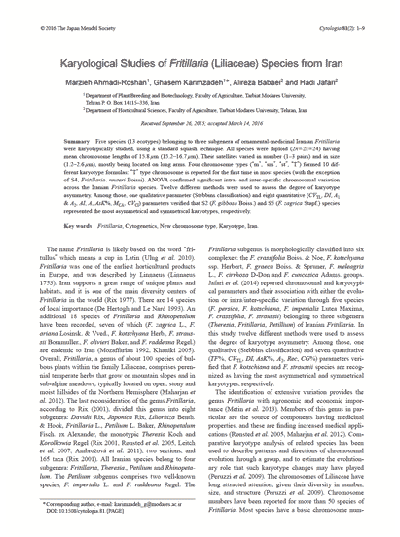NEWS 2016
Karyological Studies of Fritillaria (Liliaceae) Species from Iran
Marzieh Ahmadi-Roshan¹, Ghasem Karimzadeh¹, Alireza Babaei², Hadi Jafari²
CYTOLOGIA 81(2): 133-141 (2016)
doi: 10.1508/cytologia.81.133
¹Department of Plant Breeding and Biotechnology, Faculty of Agriculture, Tarbiat Modares University, Iran
²Department of Horticultural Sciences, Faculty of Agriculture, Tarbiat Modares University, Iran
Abstract
Five species (13 ecotypes) belonging to three subgenera of ornamental-medicinal Iranian Fritillaria were karyotypically studied, using a standard squash technique. All species were diploid (2n=2x=24) having mean chromosome lengths of 15.8 µm (15.2–16.7 µm). Their satellites varied in number (1–3 pairs) and in size (1.2–2.6 µm), mostly being located on long arms. Four chromosome types (“m”, “sm”, “st”, “T”) formed 10 different karyotype formulas: “T” type chromosome is reported for the first time in most species (with the exception of S4, Fritillaria reuteri Boissi). ANOVA confirmed significant intra- and inter-specific chromosomal variation across the Iranian Fritillaria species. Twelve different methods were used to assess the degree of karyotype asymmetry. Among those, one qualitative parameter (Stebbins classification) and eight quantitative (CVTL, DI, A1 & A2, AI, A, AsK%, MCA, CVCI) parameters verified that S2 (F. gibbosa Boiss.) and S5 (F. zagrica Stapf.) species represented the most asymmetrical and symmetrical karyotypes, respectively.




